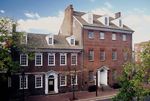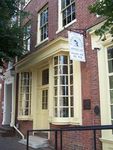Alexandria War of 1812 Commemoration War of 1812 Walking Tour
←
→
Page content transcription
If your browser does not render page correctly, please read the page content below
Alexandria War of 1812 Commemoration
War of 1812 Walking Tour
Introduction
The War of 1812 was a 32 month conflict primarily between Great Britain and the
newly independent United States. Many factors contributed to the conflict,
including the impressment of American sailors, trade disagreements, and an
attempt to claim Canadian and Native American land. War was declared on June
18, 1812, and ended three years later in a truce. The City of Alexandria was
involved in 1814, when British troops arrived and loaded supplies before attacking
Baltimore. Instead of fighting, the Alexandrians surrendered and welcomed the
British, stalling them for five days, thus giving Baltimore time to prepare for battle.
Without Alexandria, Baltimore would have most likely lost its battle with the
British.
Ramsay House Visitor Center
221 King Street, Alexandria, VA 22314
703-746-3301
VistAlexandriaVA.com
The Ramsay House was named for William Ramsay, a
Scottish merchant and the founder of Alexandria. At the
time of the War of 1812, Alexandria was a part of the
District of Columbia and had a population of about
7,200 people. It was one of the primary seaports of the
United States, thus becoming a target of the British troops during the war.
When facing market square, turn right on N Fairfax Street. The Carlyle House
will be on the right.
Carlyle House
121 N Fairfax St, Alexandria, VA 22314
703-549-2997
CarlyleHouse.orgWilliam Herbert, the son-in-law of John Carlyle, lived in this house during the War of 1812. In July 1814, William Herbert was appointed by Alexandria’s Common Council to Alexandria’s Committee of Vigilance, which was responsible for monitoring the approach of British troops. Thomas Herbert, the brother of William Herbert, was the president of the Alexandria Common Council when, in order to protect the safety of the city’s residents, it voted to surrender to the approaching British. Continue on N Fairfax Street. The Bank of Alexandria will be next to Carlyle House. Bank of Alexandria 133 N. Fairfax St., Alexandria, Virginia (Note: Not open to the public) The Bank of Alexandria was founded in 1792 by a board of directors, including William Herbert, and was established in its current location adjacent to the Carlyle House property in 1803. In early August of 1814, several commercial banks, including the Bank of Alexandria, loaned the government $200,000 in exchange for building defenses against the British, prior to knowing that British ships were coming upriver. However, in late August of 1814, the Alexandria town and county militia were called out en masse to take post between Piscataway and Fort Washington, taking all of Alexandria’s arms and artillery. When these supplies were blown up by the commander of Fort Washington, Alexandria was left defenseless against the oncoming British troops. Take a left on Cameron Street, and then take a left on N Royal Street. Gadsby’s Tavern Museum will be across the street. Gadsby’s Tavern Museum 134 N Royal St, Alexandria, VA 22314 703-746-4242 GadsbysTavern.org The buildings known as Gadsby’s Tavern today were operated by Thomas Triplett during the War of 1812. Triplett’s Hotel not
only offered travelers lodging, but also served as a place for social, political, and business gatherings. The tavern also was the place for local elections and, in December 1813, William F. Thornton was elected as a General of the infantry. Less than a year later, he would be chosen by President Madison to spy on a British camp in Maryland. The famous earlier proprietor of Gadsby’s Tavern, John Gadsby, moved from Alexandria to Baltimore in 1808 to run the Indian Queen Tavern. Francis Scott Key completed the “Star Spangled Banner” while spending the night on September 16, 1814 at the Indian Queen Tavern. Continue on N Royal Street. City Hall/Market Square is across the street from Gadsby’s Tavern Museum. City Hall/Market Square 301 King St, Alexandria, VA 22314 703-838-4000 AlexandriaVa.gov On the morning of August 29th, city residents awoke to find a battle line of British ships aimed directly at Alexandria. Even from the center of the city, the waterfront and the surrounding ships could be clearly seen. In order to protect the welfare of the city, Mayor Charles Simms agreed to surrender to the British and follow their terms and conditions. These included the taking of all armaments and goods awaiting export in the warehouses, repairing damaged ships, and providing beverages for British troops. Proceed from N Royal Street, across King Street, onto S Royal Street. The former Alexandria Gazette Office will be across the street, an unidentified address on the 100 block. Alexandria Gazette Office West side of 100 block of South Royal Street (Note: The exact address of the Alexandria Gazette Office is currently unknown) The Alexandria Gazette, Commercial and Political, was a prominent newspaper run by
Samuel Snowden and John Douglass Simms. The newspaper openly criticized the War of 1812 from its beginning and actively defended Alexandria’s choice to surrender, providing insight into the American Public’s opinion of the war. There were many ideological differences among the citizens, foreshadowing the modern political divide found in today’s society. During the British occupation of Alexandria, publication of The Alexandria Gazette ceased temporarily. Return to King Street and take a right. Turn right onto S Fairfax Street, where the Stabler-Leadbeater Apothecary Museum is on the right. Stabler-Leadbeater Apothecary Museum 105 S Fairfax St, Alexandria, VA 22314 703-746-3852 ApothecaryMuseum.org The Stabler-Leadbeater Apothecary was a prominent apothecary in Alexandria that operated in this location from 1805 until 1933. During the War of 1812, the shop was run by Edward Stabler, a Quaker who was appointed by the Religious Society of Friends to prevent Alexandrians from bearing arms against the British. Fortunately, there were no troops in Alexandria when the British arrived, resulting in the peaceful occupation of the city, rather than conflict. Continue down S Fairfax Street and then turn left on Prince Street. Follow the street to the intersection of Prince and Union Streets. Foot of Prince Street Intersection of Prince and Union Streets One of the most infamous incidents of the British occupation of Alexandria came when three US Navy officers attempted to capture a young British midshipman at the foot of Prince Street. British ships in the harbor nearly opened fire on Alexandria, resulting in panic and hysteria among residents. However, town authorities were able to convince the British to hold fire, and conflict was avoided. Walk to the left on S Union St.
Fitzgerald Warehouse 100 South Union Street During the occupation of Alexandria, British troops looted many warehouses for supplies and goods fresh from the shipping docks. This included 16,000 barrels of flour, 1,000 hogsheads of tobacco, 150 bales of cotton, $5,000 worth of wine, sugar, and other articles, and about 21 ships. This loss of resources seriously impacted Alexandria’s economy, as well as its position as a major seaport. Continue down S Union St and take a right on King Street. Then, take a left at the end of King Street to the Torpedo Factory. Stand facing the Potomac River. The Torpedo Factory/Waterfront 105 N Union St, Alexandria, Virginia 22314 703-838-4565 TorpedoFactory.org After five days of occupation, British troops left Alexandria to attack Baltimore. However, Baltimore residents had spent those five days preparing for battle, resulting in their ultimate victory. Without the surrender of Alexandria and the delay of the British ships, the War of 1812 may have been lost, and the United States as we know it would have been changed forever. The End of the War of 1812 The War of 1812 ended with the signing of the Treaty of Ghent by President Madison on February 17, 1815. Though the winner of the war was inconclusive, it created a sense of unity and nationalism among Americans. Many of the symbols and songs most commonly associated with the United States, such as the bald- headed eagle, Uncle Sam, and the Star-Spangled Banner, originated during the conflict. Most importantly, the War of 1812 created a feeling of patriotism in the newly-founded United States, a feeling that has become part of the cultural identity of America. War of 1812 Walking Tour created by Alex Bulova Troop 1865 Eagle Scout project, 2014.
You can also read
























































